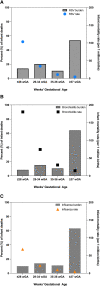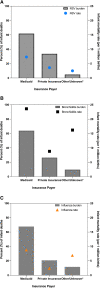Mortality Associated With Respiratory Syncytial Virus, Bronchiolitis, and Influenza Among Infants in the United States: A Birth Cohort Study From 1999 to 2018
- PMID: 35968877
- PMCID: PMC9377030
- DOI: 10.1093/infdis/jiac127
Mortality Associated With Respiratory Syncytial Virus, Bronchiolitis, and Influenza Among Infants in the United States: A Birth Cohort Study From 1999 to 2018
Abstract
Background: Infant mortality due to respiratory syncytial virus (RSV) in the United States is not well understood.
Methods: From 1999 to 2018, RSV, bronchiolitis, and influenza deaths were described for infants <1 year using linked birth/death datasets from the National Vital Statistics System. Mortality was described overall and by infant birth and death characteristics. Bronchiolitis was included as the plausible upper limit of RSV, while influenza served as a comparator.
Results: Total infant deaths were 561 RSV, 1603 bronchiolitis, and 504 influenza, and rates were 6.9 (95% confidence interval [CI], 6.4-7.5), 19.8 (95% CI, 18.9-20.8), and 6.2 (95% CI, 5.7-6.8) per 1 000 000 live births, respectively. The highest RSV rates were observed among <29 weeks' gestational age infants (103.5; 95% CI, 81.8-129.1), American Indian/Alaskan Native (20.3; 95% CI, 11.6-33.0), and Medicaid-insured (7.3; 95% CI, 5.9-8.9). However, RSV mortality burden was greatest in full-term (53.7%), white (44.9%), and Medicaid-insured (61.7%) infants. Deaths outside the inpatient setting were 21% and 54% for RSV and bronchiolitis; more Medicaid- (58%) and other/unknown-insured (69%) infants with bronchiolitis died outside of the inpatient setting, compared to privately insured infants (48%) (P = .0327).
Conclusions: These national estimates emphasize the importance of considering all infants across all healthcare settings when describing RSV mortality.
Keywords: RSV; bronchiolitis; infants; influenza; mortality; respiratory syncytial virus.
© The Author(s) 2022. Published by Oxford University Press on behalf of Infectious Diseases Society of America.
Conflict of interest statement
Potential conflicts of interest. EpidStrategies received a grant from Sanofi for this research. H. R., M. S., X. J., N. M., L. C. B., and J. P. F. are employees of EpidStrategies. C. B. N. is an employee of Sanofi and may hold shares and/or stock options in the company. All authors have submitted the ICMJE Form for Disclosure of Potential Conflicts of Interest. Conflicts that the editors consider relevant to the content of the manuscript have been disclosed.
Figures






Similar articles
-
The Use of Death Certificate Data to Characterize Mortality Associated With Respiratory Syncytial Virus, Unspecified Bronchiolitis, and Influenza in the United States, 1999-2018.J Infect Dis. 2022 Aug 15;226(Suppl 2):S255-S266. doi: 10.1093/infdis/jiac187. J Infect Dis. 2022. PMID: 35968872 Free PMC article.
-
Respiratory Syncytial Virus Burden and Healthcare Utilization in United States Infants <1 Year of Age: Study of Nationally Representative Databases, 2011-2019.J Infect Dis. 2022 Aug 15;226(Suppl 2):S184-S194. doi: 10.1093/infdis/jiac155. J Infect Dis. 2022. PMID: 35968879 Free PMC article.
-
Respiratory Syncytial Virus Is the Leading Cause of United States Infant Hospitalizations, 2009-2019: A Study of the National (Nationwide) Inpatient Sample.J Infect Dis. 2022 Aug 15;226(Suppl 2):S154-S163. doi: 10.1093/infdis/jiac120. J Infect Dis. 2022. PMID: 35968878 Free PMC article.
-
Mortality Among US Infants and Children Under 5 Years of Age with Respiratory Syncytial Virus and Bronchiolitis: A Systematic Literature Review.J Infect Dis. 2022 Aug 15;226(Suppl 2):S267-S281. doi: 10.1093/infdis/jiac226. J Infect Dis. 2022. PMID: 35968871 Free PMC article.
-
A Systematic Literature Review of the Burden of Respiratory Syncytial Virus and Health Care Utilization Among United States Infants Younger Than 1 Year.J Infect Dis. 2022 Aug 15;226(Suppl 2):S195-S212. doi: 10.1093/infdis/jiac201. J Infect Dis. 2022. PMID: 35968876 Free PMC article.
Cited by
-
Health economic evaluation of implementing a universal immunization program with nirsevimab compared to standard of care for the prevention of respiratory syncytial virus disease in Canadian infants.Hum Vaccin Immunother. 2025 Dec;21(1):2480875. doi: 10.1080/21645515.2025.2480875. Epub 2025 Apr 5. Hum Vaccin Immunother. 2025. PMID: 40186452 Free PMC article.
-
All Infants Are at Risk of Developing Medically Attended Respiratory Syncytial Virus Lower Respiratory Tract Infection and Deserve Protection.J Infect Dis. 2022 Aug 15;226(Suppl 2):S148-S153. doi: 10.1093/infdis/jiac244. J Infect Dis. 2022. PMID: 35968870 Free PMC article. No abstract available.
-
Respiratory Syncytial Virus Hospital-Based Burden of Disease in Children Younger Than 5 Years, 2015-2022.JAMA Netw Open. 2024 Apr 1;7(4):e247125. doi: 10.1001/jamanetworkopen.2024.7125. JAMA Netw Open. 2024. PMID: 38635270 Free PMC article.
-
Risk Analysis of Respiratory Syncytial Virus Among Infants in the United States by Birth Month.J Pediatric Infect Dis Soc. 2024 Jun 28;13(6):317-327. doi: 10.1093/jpids/piae042. J Pediatric Infect Dis Soc. 2024. PMID: 38738450 Free PMC article.
-
Experience of an Italian Pediatric Third Level Emergency Department during the 2022-2023 Bronchiolitis Epidemic: A Focus on Discharged Patients and Revisits.Children (Basel). 2024 Feb 21;11(3):268. doi: 10.3390/children11030268. Children (Basel). 2024. PMID: 38539303 Free PMC article.
References
-
- Leader S, Kohlhase K. Recent trends in severe respiratory syncytial virus (RSV) among US infants, 1997 to 2000. J Pediatr 2003; 143:S127–32. - PubMed
-
- Committee on Infectious Diseases . Recommendations for prevention and control of influenza in children, 2021–2022. Pediatrics 2021; 148:e2021053745. - PubMed
Publication types
MeSH terms
LinkOut - more resources
Full Text Sources
Medical

